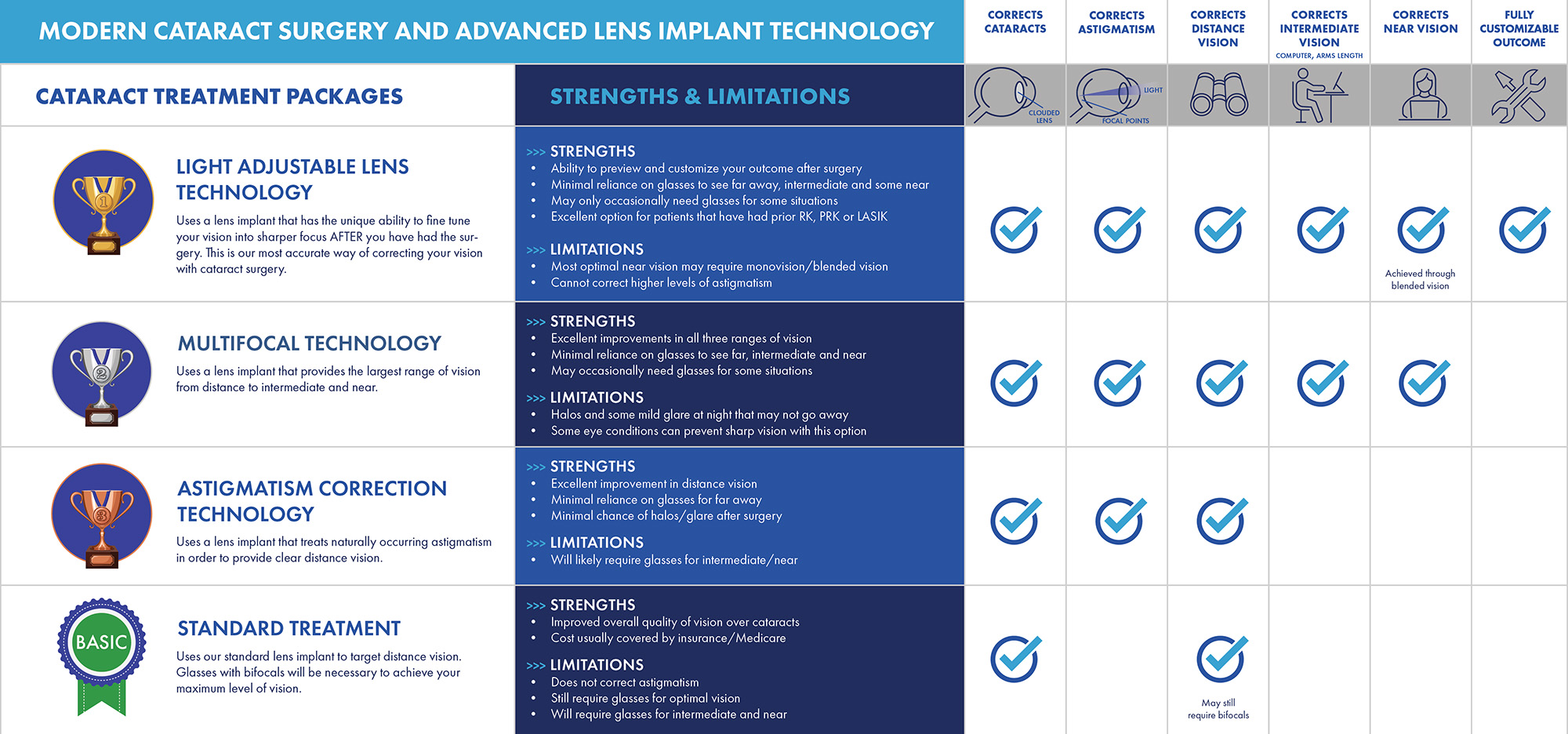


If you or someone you love has cataracts, you might understand the frustrations of living with the symptoms that come along with having them. The good news is that cataract surgery is one of the most commonly performed and safest procedures in medicine.
Texas Vision is one of the leading providers of cataract surgery in Central Texas. Our highly trained, vastly experienced surgeons perform thousands of cataract surgeries a year. Utilizing only the most advanced technology and striving to make the procedure as convenient and safe as possible, we are determined to provide only the best care for each and every patient.

A cataract develops when the ordinarily transparent natural lens of the eye becomes cloudy. This occurs when proteins in the lens begin to break down and start clumping together.
Because it takes a long time for cataracts to develop fully, you may not realize you have a cataract at first.
Vision, in general, starts to blur, but it is especially noticeable when driving or watching TV from a normal distance.
Because a cataract allows less light through the lens, it may become more bothersome in low light conditions, especially when trying to drive at night.
Many people find it difficult to drive towards the sun. They also find it harder to see golf balls against a bright sky, even though vision may seem acceptable under other circumstances.
Colors and tone may begin to fade and appear more yellow as the cataract worsens.
Because the cataract is clouding the way light enters the eye, some may experience double but incomplete images.







If you find out that you need cataract surgery, it’s always helpful to know what to expect before you have it. Cataract surgery is a minimally invasive procedure with a low risk of complications.
It’s the most commonly performed medical procedure! Your surgeon will remove your natural lens during the procedure and then replace it with an artificial lens, known as an intraocular lens (IOL).
The intraocular lens allows you to see clearly after cataract surgery, and there are many kinds of IOLs available, depending on your visual needs, lifestyle, and goals after cataract surgery.
The right choice of IOL for you is based on what you are looking to get out of the procedure and the recommendations of your ophthalmologist.

At Texas Vision, we offer our patients the following intraocular lenses (IOL) in three main categories:
Our basic option is a monofocal lens, which is a clear lens that contains a single focus. It’s set to focus on either seeing up close, seeing things in between, or looking at something further away.
People that choose the basic lens are aware that they will likely need bifocals or glasses for both seeing well at a distance and near and are fine with the need for glasses or contacts.
Astigmatism is a refractive error that occurs when the cornea is an irregular shape. Instead of being more like a basketball, the cornea is closer in shape to a football. The difference in the shape of the cornea results in blurry or distorted vision.
For patients that want to correct astigmatism while removing their cataracts, there are toric lenses. These lenses will help to correct distance vision but you may tend to need glasses for your near activities, including using your computer, cell phone, or reading a book.
Our Full Focus lenses can correct distance vision but have a larger range of vision built into them so we can provide better intermediate to near vision. This category is for people that would like more independence from glasses for both distance and near vision. There are two types of lenses within this category – Multifocal Lenses and Extended Range of Focus Lenses.
For patients looking to see at both a distance and up-close simultaneously, a premium option like a multifocal lens does this and more. A multifocal lens has the largest range of vision than any of the lenses. The range of vision includes distance vision all the way into your casual reading range of vision.
The lens includes rings, like rings of a tree, for your eye to focus through to see both near and far. There is no head tilt or positional needs, like bifocals, to see through these rings, but due to these rings, patients may notice some halos around lights at night. Because of the large range of vision that this lens provides, most people no longer need glasses going forward.
Another popular option is the Light Adjustable Lens (LAL). This innovative technology offers something unique – the ability to fully customize your vision after surgery. The LAL lens, like the Multifocal, provides a full range of vision, including distance vision all the way to casual reading range.
The popular aspect of this lens is we can further customize and personalize the lens power after the lens is implanted. This unique feature addresses any variations that happen through the healing process and ultimately allows you to “test drive” different vision options to make sure it’s perfect for your needs.


Georgetown Office
4134 Williams Dr.
Georgetown TX 78628
Tel: (512) 551-5500
Fax: (512) 551-5509
info@texasvision.com
Office Hours
Mon – Tues: 8:00 – 3:30
Wed – Fri: 8:00 – 5:00
Sat – Sun: Closed
Cedar Park Office
1130 Cottonwood Creek Trl Ste D4
Cedar Park, TX 78613
Tel: (512) 551-5500
Fax: (512) 551-5509
info@texasvision.com
Office Hours
Mon – Fri: 8:00 – 5:00
Sat – Sun: Closed
Temple Office
5258 South 31st St
Temple, TX 76502
Tel: (254) 314-8001
Fax: (254) 314-8021
info@texasvision.com
Office Hours
Mon – Thurs: 8:00 – 5:00
Fri: 8:00 – 3:00
Sat – Sun: Closed
Service Locations
Cedar Park
Temple
Austin
Georgetown
Leander
Round Rock
Sun City
Killeen
*Please do not include personal identifying information such as your birth date, or personal medical information in any emails you send to us.